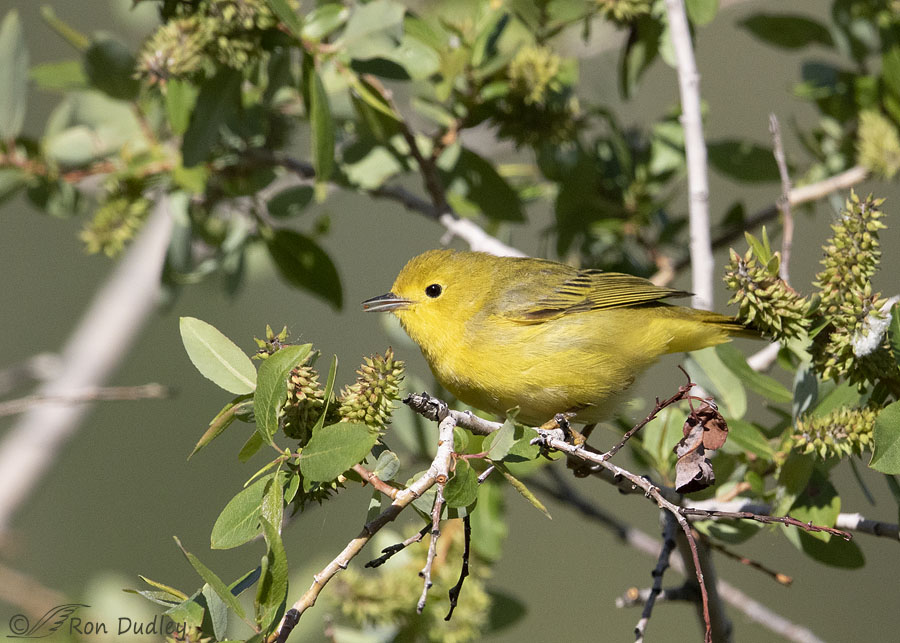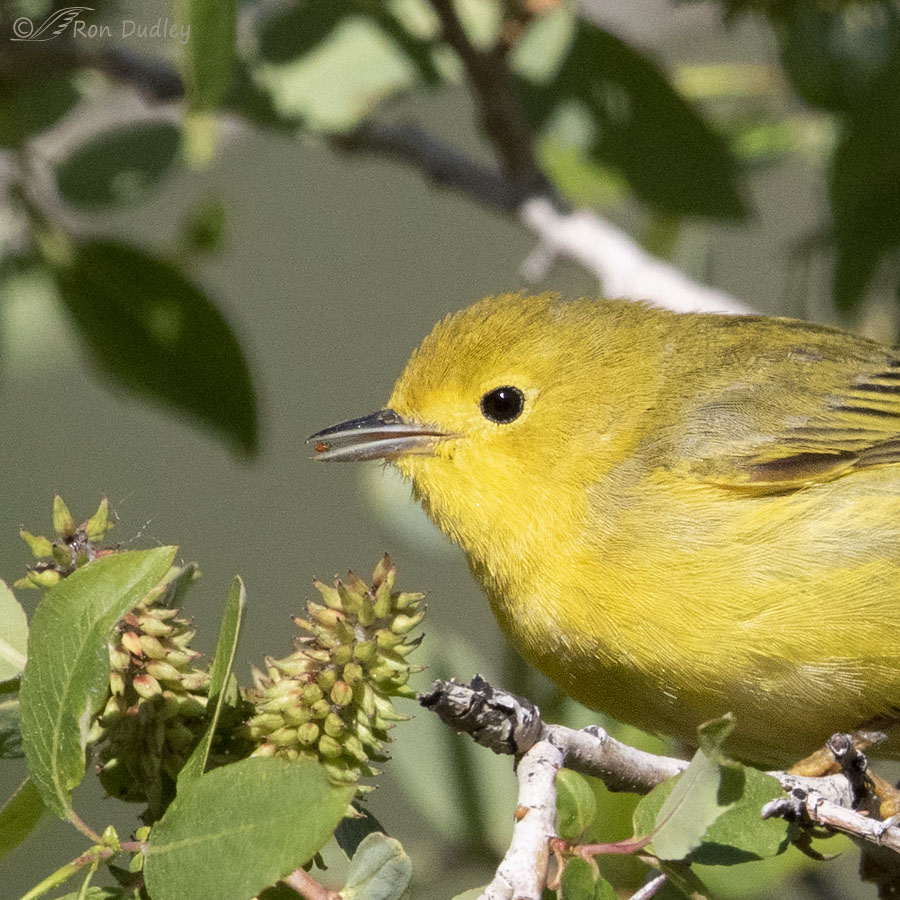An itty bitty snack.

1/6400, f/6.3, ISO 800, Canon 7D Mark II, Canon EF 500mm f/4L IS II USM + EF 1.4 III Extender, not baited, set up or called in
I’m always interested in documenting what birds are eating, even when it’s very small. Maybe especially when it’s small because those types of snacks are harder to see in my photos and birds eat them so quickly they usually go unnoticed. Or at least unidentified.
I photographed this Yellow Warbler in the mountains four days ago and even though the bird was small in the original frame I still had enough detail to see the food item in its bill. I believe it’s an aphid.
Most aphids I see are green but they can be green, yellow, brown, red or black. This one appears to be reddish brown.
I can’t imagine how many of these tiny sap-sucking insects are required to fuel the frenzied activities of hyperactive birds like warblers. Which partially explains why warblers tend to be so difficult to photograph well – in their quest to get enough food they’re constantly flitting around in the bushes and trees at almost warp speed.
Moving targets indeed.
Ron
Note to photographers:
As I said this bird was small in the frame to start with. In order to see the aphid as clearly as possible the second version of the photo above was cropped to only 7.5% of the original photo (1.5 MP of 20 MP). So even though the loss of image quality in such a severe crop is substantial and obvious I was still pleased with the sharpness and detail.



You definitely scored on Degree of Difficulty! Amazing image and detail!
Thank you, Marty.
Amazing detail: feathers, eye ring, and seeing that the aphid is not smashed seems to speak to the sensitivity of its beak.
Thanks, Lyle.
Hooray for the warbler! Aphids might be tiny but they also seem to need to eat a lot (they and their huge family seem to need to eat a lot).
And how amazing to be able to crop so much and retain detail. Loud applause.
EC, as you mention their huge families are also part of the equation – both in the damage they do and in the amount of food they provide for birds.
Such a beautiful little bird, nice of him to find the perfect spot to pose for you. I regret I don’t have enough warblers visit my yard to counteract the number of aphids who do! So I end up scraping them off the stems or leaves of plants (milkweed for Monarchs, in particular) with my fingers and end up with a yucky orange mess. It’s kind of satisfying but I’d rather have the warblers!
“It’s kind of satisfying but I’d rather have the warblers!”
I get that, Chris. Have you tried spraying them off with a hose?
I’m a big-time water saver here—the drought is unrelenting, as you know—so yucky fingers are a small sacrifice, more precise, too. I know the plants would like the overspray, but they get some of that when I rinse my fingers using a bucket of (saved) water!
Bless ANY bird that eats an aphid. Thanks, Ron!
Said from the heart by a gardener I’ll bet.
The aphid may be small but it is usually a sweet snack. Aphids produce honeydew, a sweet sticky liquid exuded from their rear end. When they pierce aa plant cell (and they are tiny, piercing only a single cell) the pressure in the plant cell forces a drop of honeydew out the end of the aphid. Some ants “farm” aphids just for this purpose. There is a population of Townsend’s Warblers that spends the winter in the mountains of Mexico. While there they also feed on the honeydew, being very careful not to kill the aphid so that it can produce more of this sweet liquid. Many other birds are aware of this sweet treat but unlike these Townsend’s Warblers, haven’t learned the trick of not taking the whole aphid. After all, the aphid is also food, if only a very small amount.
Interesting, Dan. Thank you.
Precious!!! Am in love with the bright yellow feathers.
Thanks, Kathleen.
As one who suffers from chronic “warbler neck”, I really appreciate the superb photograph of this beautiful bird! Excellent enlargement to show that teensy tidbit.
It’s sorta like me having a sunflower seed for a snack. It’s okay, but pretty soon I’ll be looking for a steak.
That Yellow Warbler is no doubt thinking: “There just HAS to be a juicy caterpillar here somewhere!”
Ron, thank you for continuing to share your expertise, wonderful photographs and infinite love of nature. It is appreciated.
“It’s sorta like me having a sunflower seed for a snack”
Wally. while I was writing this post I was looking for an effective and appropriated analogy. I like yours.
Great shots. These Warblers and others are so very difficult to photograph when they are in eating mode. I don’t know much about how many insects they need to need daily, but guessing it is a lot. Contemporary photographic equipment has helped to greatly increase our knowledge and enjoyment of all wildlife and birds.
Thank you, Everett.
Great capture, Ron! Your skills and equipment are wonderful being able to crop to that extent and have it come out well. They are tiny, busy, fast birds…….take a LOT of aphids to fuel them – energy available from them must be worth it. Of course, there are generally MANY aphids when they are present.
They are tiny, busy, fast birds…….take a LOT of aphids to fuel them – energy available from them must be worth it. Of course, there are generally MANY aphids when they are present.
Good point about the number of aphids often available to them, Judy. Thanks.
What a magnificent commentary on photographic capabilities, and your assiduousness, in particular! I love being able to enlarge that photo you posted, and actually see those little legs of the aphid pressing against the beak! And one more reason to love those warblers! I love seeing them dart amongst the wetlands at the foot of my dirt road…
Thank you, Alison. I’m jealous of your dirt road, presumed dust and all.
When I read your post title, I thought “No way, aphids are almost invisible!!” Accept my apologies for doubting you
No apology necessary, Terri. I might have thought the same thing.